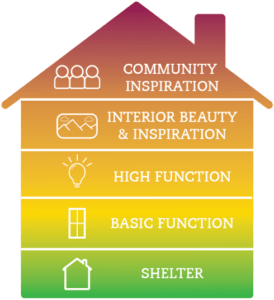Image Credit: itsnnnoa on unsplash.com
To read more of Joe Neri's article, please click here.
Nonprofit facilities communicate, and we need to be more conscious, thoughtful, and vocal about what they say about who and what our organizations value. A dilapidated and dysfunctional facility communicates that the work conducted inside it is unimportant, the people served deserve no better, and the surrounding neighborhood is forgotten and forsaken.
In contrast, a facility with functional—even beautiful—design sends a clear, edifying message to its occupants, visitors, and the neighborhood that they are important, with intrinsic value and a realizable vision of hope.
A Hierarchy of Nonprofit Facilities’ Needs
After 30 years in community development, I have come to think of nonprofit facilities as existing on a continuum of need. Psychologist Abraham Maslow theorized a hierarchy of human needs, a motivational model that transitions from basic physiological needs like food and shelter, through safety and security, to self-esteem and self-actualization. As I suggest in the graphic below, nonprofit facilities exist on a similar hierarchy—with physical, psychological, and economic needs that must be met before an agency can transition to the next stage of its work.

Perhaps, if those of us who care deeply about nonprofits—and particularly about agencies dedicated to serving low-income communities—name and discuss these tensions and the underlying value choices involved, we can start to prioritize, manage, and mitigate them. Here are a few ideas on how to begin:
- Board members: Stop challenging your agency directors about facilities that look “too good.” Resist the insinuation that quality facilities will make it more difficult to convince donors that your agency needs money.
- CDFIs: Stop limiting loans to nonprofit agencies in response to property appraisals. Appraisal-based lending severely limits lending for nonprofit facility projects, particularly in formerly redlined communities where decades of devaluation have made it nearly impossible for nonprofits to obtain the resources needed to develop their facilities. Appraisers are never going to value the hope and inspiration that comes from a well-designed nonprofit facility, but CDFIs can—and must!
- Banks: Find ways to help. Banks can underwrite loans, even while maintaining an abundance of caution that, instead of relying on a flawed appraisal system, responsibly lends beyond appraised value. If each bank made a few such loans, the impact in neglected communities would go far beyond the loans’ dollar values.
- Foundations and donors: Remember that most programs require a facility and that the quality of that facility enhances or detracts from the program being funded. Stop treating human services, childcare, education, and healthcare as functions separate from community development. Quality nonprofit facilities are community development. Every quality nonprofit facility changes the profile and trajectory of its community, not just through the vital services it provides, but through its very physical presence, which reminds the community in which the facility is located of the community’s value and the agency’s investment in it.

Comments (0)